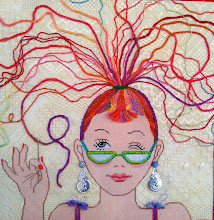We creators of needle art are so fortunate to have thousands of different threads at our disposal; thousands of colors, and hundreds of textures and thread types. We have cottons, silks, linens, wools, synthetics, and metallics..even wires. We have single plies, multi plies; smooth, crinkly, shiny, matt. We have overdyed, and we have neon brights. We have every hue and texture on the planet at our disposal. So WHY, you ask, would I even want to add color to my stitches?
Because it is fun. Because it is easy. (I'm a lazy stitcher!) Because it is artistic. Because it expands the possibilities for creating the look I want, and better yet, for a look I don't even know is possible!
Just remember...when you are confined to a grid upon which to create your stitches, and use a manufactured thread, the look of your stitches is 'confined' as well. Often, I have found this to be too restrictive for my artistic nature. I want my work to have a more fluid quality to it, in that I want to control the look of the stitch. The stitch does not control me! (Wow! I like how that sounds! Makes me feel powerful, ya know?) And it is very satisfying to bring the work to a level that stitching alone cannot do.
I'm still laughing many years later, about a comment I overheard someone make in my tradeshow booth. Two women were viewing a model that I stitched with all white threads, and then painted the whole thing AFTER it was stitched. One woman muttered under her breath to her friend, "Hasn't she ever heard of DMC?" Well! She completely missed the point! And I would double dare her to get the same effect with thread alone, and that is not dismissing how much I love DMC threads either!
Here is a portion of the piece being discussed.
Bear in mind, this oak leaf was stitched with all white DMC floss, and generously wetted down and painted after being stitched. Here are some simple directions:
Use watered down acrylic paints (available at any craft store), mixed with a little Textile Medium, an additive for paint, to keep the paint soft after it dries. (Also available at the craft store). Wet the entire canvas generously with a sponge, and then go to town with the paint and a brush. Don't be timid! The canvas is still mounted on stretcher bars for this...and it will remain on the stretcher bars for the entire time you are working on the project. When you are painting, put a layer of paper towels underneath to absorb the water. Paint, paint, paint! Broad stokes. Let the paint flow. Tip the canvas different directions to let the paint 'run' in the background.
Next, lay the canvas outside to dry in the sun. Another way is to lay it in the bathroom sink and go at it with a hair blow dryer. You can also lay it on the floor (paper towels beneath) and dry with the hair dryer that way too. When it is good and dry, you are ready to stitch some more. In the above piece,
additional overdyed threads by Caron were added in the veins and background after it was dry.
So, my question to this woman now would be: How would you have achieved the same subtle shading and color gradations without a break, in the long straight line of upright stitches? And what about that really great bleeding of color in the background that resulted from this technique? Sure, it could have been a painted canvas with those markings in the background, and sure, you could have used different stitches on the leaf to create shading, but that isn't the way I wanted to do it. I wanted to create the leaf with a fusion of thread and paint, enjoying the creative joy of discovery resulting from the process. And I will add, that when my students have stitched and painted this same leaf design, no two have ever been alike, and every single one has been uniquely beautiful, bearing the individual 'hand' of the person who created it! This sets it apart from other painted canvas projects, where students end up with the exact same results (if they follow the directions explicitly).
Ok...that is only one way to tint a thread! Another less dramatic, but no less beautiful way to 'tint your stitch,' is illustrated to perfection by esteemed needlepoint canvas artist, Melissa Shirley. www.melissashirleydesigns.com Melissa graciously shared a portion of her stitch guide instructions along with this photo of her Indian Maiden. Her stitch tinting method involves using colored pastels (chalks). Here is Melissa's stunning piece, and her description follows.
Using a short bristled, artist’s paint brush called a “bright” and a quality set of soft pastels, you can rub the brush on the pastel and apply shading colors directly onto the stitching. This technique was
used on the following areas of the Indian Maid. TIP-If you use this technique, practice on a separate piece of practice stitching. It’s best to start with less pigment and add more if needed.
Maid’s cheeks and fawn's ears-warm coral pink
Folds of the blouse and skirt - warm grey
Golden detail at the bottom of the skirt-rusty orange
Centers of the top corner flowers-rusty orange
Bushes-dark greens
Tree trunks-charcoal grey
Tree foliage-dark greens
Fawn chest-dark brown
Bird-rusty orange
Foreground-dark brown
I hope this entry inspires you to go outside your comfort zone of prescribed stitches and threads, to transform them in a way you have not considered before. Be brave! Remember...there are no mistakes in creativity...only discovery!





